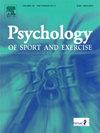在述情障碍人群中,自我控制努力对随后身体表现的影响
IF 3.3
2区 心理学
Q2 HOSPITALITY, LEISURE, SPORT & TOURISM
引用次数: 0
摘要
最初的自我控制努力会损害随后的身体表现,疼痛和动机的感知被认为是潜在的机制。在这种情况下检查状态焦虑是至关重要的,因为减少可能反映了述情障碍运动员对努力的适应性情绪反应。虽然还有待探索,但与述情障碍相关的有限的情绪意识和调节可能会缓冲自我控制努力的性能消耗效应。本研究填补了这一空白,并探讨了疼痛、动机、RPE和状态焦虑作为潜在的机制。采用主题内交叉设计,40名参与者(年龄18-45岁;男性27人,女性13人;20名述情者和20名非述情者分别在非自我控制任务(一致的Stroop)和自我控制任务(不一致的Stroop)之后完成了两次坐墙至精疲力竭。疼痛、动机和RPE在坐墙期间每15秒和30秒记录一次,而状态焦虑则在坐墙前、坐墙后立即和10分钟后测量。自我控制努力对组间表现的影响不同。非述情障碍的个体表现出显著的成绩下降,与非述情障碍的个体相比,自我控制运动后,他们更早地退出壁式静坐(p = 0.007)。相比之下,有述情障碍的个体在自我控制运动后进行壁式静坐的时间明显长于无运动的个体(p <;0.001)。多层次模型显示,与非述情者相比,述情者的疼痛和RPE随着时间的推移有更大的增加,同时动机也有更大的下降,尤其是在自我控制努力的条件下。尽管报告焦虑加剧,但述情障碍患者的表现并没有下降,这表明在情感挑战的情况下有潜在的适应性益处,这值得在不同的运动中进一步探索。本文章由计算机程序翻译,如有差异,请以英文原文为准。
The effects of self-control exertion on subsequent physical performance in an alexithymic population
Initial self-control exertion can impair subsequent physical performance, with perceptions of pain and motivation proposed as potential mechanisms. Examining state anxiety in this context is critical, as reductions may reflect more adaptive emotional responses to exertion in alexithymic athletes. Whilst yet to be explored, the limited emotional awareness and regulation associated with alexithymia may buffer against the performance-depleting effects of self-control exertion. This study addresses this gap and examines pain, motivation, RPE, and state anxiety as potential mechanisms. Using a within-subject crossover design, 40 participants (aged 18–45 years; 27 male, 13 female; 20 alexithymic, 20 non-alexithymic) completed a wall-sit to exhaustion twice, following either a non-self-control task (congruent Stroop) or self-control task (incongruent Stroop). Pain, motivation, and RPE were recorded at 15-s and every 30-s thereafter during the wall-sit, while state anxiety was measured pre-wall-sit, immediately post-wall-sit, and 10-min post. Self-control exertion influenced performance differently between groups. Non-alexithymic individuals exhibited significant performance decrements, quitting the wall-sit sooner following self-control exertion compared to the non-exertion condition (p = 0.007). In contrast, alexithymic individuals performed the wall-sit for significantly longer following self-control exertion compared to the non-exertion condition (p < 0.001). Multilevel modelling revealed greater increases in pain and RPE over time, alongside steeper motivation declines, for alexithymic individuals compared to non-alexithymic individuals, particularly under self-control exertion conditions. Despite reporting heightened anxiety, alexithymic individuals did not experience performance declines, indicating a potential adaptive benefit in emotionally challenging situations, which warrants further exploration across different sports.
求助全文
通过发布文献求助,成功后即可免费获取论文全文。
去求助
来源期刊
CiteScore
6.40
自引率
5.90%
发文量
172
审稿时长
69 days
期刊介绍:
Psychology of Sport and Exercise is an international forum for scholarly reports in the psychology of sport and exercise, broadly defined. The journal is open to the use of diverse methodological approaches. Manuscripts that will be considered for publication will present results from high quality empirical research, systematic reviews, meta-analyses, commentaries concerning already published PSE papers or topics of general interest for PSE readers, protocol papers for trials, and reports of professional practice (which will need to demonstrate academic rigour and go beyond mere description). The CONSORT guidelines consort-statement need to be followed for protocol papers for trials; authors should present a flow diagramme and attach with their cover letter the CONSORT checklist. For meta-analysis, the PRISMA prisma-statement guidelines should be followed; authors should present a flow diagramme and attach with their cover letter the PRISMA checklist. For systematic reviews it is recommended that the PRISMA guidelines are followed, although it is not compulsory. Authors interested in submitting replications of published studies need to contact the Editors-in-Chief before they start their replication. We are not interested in manuscripts that aim to test the psychometric properties of an existing scale from English to another language, unless new validation methods are used which address previously unanswered research questions.

 求助内容:
求助内容: 应助结果提醒方式:
应助结果提醒方式:


